Some of most popular readings about Nepal
 Title: Trekking in The Nepal Himalaya
Title: Trekking in The Nepal Himalaya
ISBN: 9781741041880
Authors: Bradley Mayhew, Joe Bindloss
Publisher: Lonely Planet
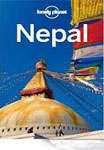 Title: Nepal Travel Guide
Title: Nepal Travel Guide
ISBN: 9781741797237
Authors: Bradley Mayhew, Trent Holden, Lindsay Brown
Publisher: Lonely Planet
 Title: Nepal: The Rough Guide
Title: Nepal: The Rough Guide
Author: David Reed, Andy Balestracci, Charles Leech, Anna Robinson, Carol Tingey, Kesang Tseten, Gopal Yonjan
Publisher: Rough Guides
Unique routes for in-depth cultural experiences of Nepal
THE CHITWAN CHEPANG HILLS TRAIL
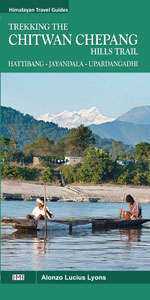 This pristine trail is an ideal choice for those seeking cultural interaction away from popular, commercialized routes and can be conveniently combined with a visit to the World Heritage Site (Natural) of Chitwan National Park. The Chepang ethnic group (also known as Chyobang and Praja), live primarily in the Chitwan Hills. They previously engaged in slash-and-burn agriculture and were hunter gatherers with a nomadic lifestyle, at times subsisting on roots and general foraging. Nowadays, many Chepang have settled in villages and have adopted progressive horticultural methods. However, some members still engage in nomadic practices, especially outside of growing seasons, often relying on forest resources and even hunting with bow and arrow.Other ethnicities predominant along this route include the Giripuri (a subgroup of Chhetri which is a warrior caste that includes the former royal family), Magar, Bahun (Brahmin), and Newar.
This pristine trail is an ideal choice for those seeking cultural interaction away from popular, commercialized routes and can be conveniently combined with a visit to the World Heritage Site (Natural) of Chitwan National Park. The Chepang ethnic group (also known as Chyobang and Praja), live primarily in the Chitwan Hills. They previously engaged in slash-and-burn agriculture and were hunter gatherers with a nomadic lifestyle, at times subsisting on roots and general foraging. Nowadays, many Chepang have settled in villages and have adopted progressive horticultural methods. However, some members still engage in nomadic practices, especially outside of growing seasons, often relying on forest resources and even hunting with bow and arrow.Other ethnicities predominant along this route include the Giripuri (a subgroup of Chhetri which is a warrior caste that includes the former royal family), Magar, Bahun (Brahmin), and Newar.
QUICK FACTS AND HIGHLIGHTS:
best time to visit: cool season (November through February as well as late October)
environment: subtropical to mid-hills
maximum elevation:Siraichuli Peak (6338 feet, 1932 m)
minimum elevation:Hugdi Bazaar (965 feet, 294 m)
facilities: teahouses, home stay
duration: from 4 days to a week
difficulty level: easy
formalities: Nepal Visa on arrival ($25 USD for 15 days, $40 USD for 30 days, or $100 USD for 3 months); Trekking Information Management System (TIMS) card currently not needed
food and lodging costs: minimal
typical Nepali dish:daal-bhattarakaari (rice, lentil soup and vegetables)
typical drink:chiyaa (sweet milk tea)
highlights:Chepang and hills people of Nepal, cultural interaction, village scenery, Nepali hospitality, Himalayan panoramas, bird watching, fort ruins, waterfalls, Bat Cave
THE KATHMANDU VALLEY RIM AND BEYOND
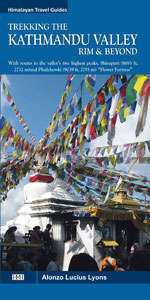 This trail may be an attractive option for people with time to spare in Kathmandu, perhaps before a flight home or if a 'banda', a regional or national strike, brings vehicle transport to a standstill. Generally, it is a way to escape from the city, if only for a 3-4 day excursion. Sensational Himalayan panoramas complement the relatively fresher air once you reach the Shivapuri Ridge, to the northeast of the valley, and beyond. Lodging facilities are available along the route, with camping and home stay possibilities, too. Also included are descriptions to Kathmandu valley’s two highest summits, Shivapuri (8963 feet, 2732 m) to the north, considered a sacred hangout of the Hindu deity Shiva, and Phulchowki (9039 feet, 2755 m) to the south which means “Flower Fortress”. Both mountains are lavishly camouflaged in vegetation and offer magnificent vistas of the valley and the snowy Himalaya beyond.
This trail may be an attractive option for people with time to spare in Kathmandu, perhaps before a flight home or if a 'banda', a regional or national strike, brings vehicle transport to a standstill. Generally, it is a way to escape from the city, if only for a 3-4 day excursion. Sensational Himalayan panoramas complement the relatively fresher air once you reach the Shivapuri Ridge, to the northeast of the valley, and beyond. Lodging facilities are available along the route, with camping and home stay possibilities, too. Also included are descriptions to Kathmandu valley’s two highest summits, Shivapuri (8963 feet, 2732 m) to the north, considered a sacred hangout of the Hindu deity Shiva, and Phulchowki (9039 feet, 2755 m) to the south which means “Flower Fortress”. Both mountains are lavishly camouflaged in vegetation and offer magnificent vistas of the valley and the snowy Himalaya beyond.
QUICK FACTS AND HIGHLIGHTS:
best time to visit: all season (clearest views from fall to spring)
environment: mid-hills
maximum elevation:Chisaapaani (7110 feet, 2167 m); Shivapuri Peak (8963 feet, 2732 m); Phulchowki Peak (9039 feet, 2755 m)
minimum elevation:Sundarijal (4560 feet, 1390 m)
facilities: lodges and hotels, teahouses, home stay
duration: 3-4 days to a week
difficulty level: easy
formalities: Nepal Visa on arrival ($25 USD for 15 days, $40 USD for 30 days, or $100 USD for 3 months); Shivapuri National Park Entry Fee, 250 NRS (500 NRS for mountain bikers) ;
Trekking Information Management System (TIMS) card,
currently not needed
food and lodging costs: minimal to expensive
typical Nepali dish:daal-bhattarakaari (rice, lentil soup and vegetables)
typical drink:chiyaa (sweet milk tea)
highlights: near to Kathmandu for an easy getaway from city life, fresh air and peaceful surroundings, village scenery, Nepali hospitality, Himalayan panoramas, Namo Buddha religious site, terraced fields of Balthali, Panauti’s ancient temples (a tentative World Heritage Site listing)
THE TAMANG HERITAGE TRAIL
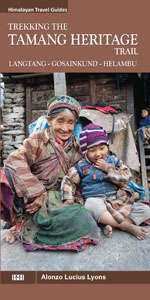 The Tamang Heritage Trail lies west of the Langtang valley. The scenic route passes through mainly Tamang villages in the mid-hills that receive considerably fewer tourists than the traditional, adjoining Langtang trek. Himalayan panoramas and village vistas are sensational and home stay enables a deeper cultural experience than can be had on the more established routes. The Tamang ethnic group comprises about 6 percent of the total population of Nepal, and they are the predominant inhabitants of Rasuwaa District where this trek and the Langtang Valley lie. Tamang have a unique language, manner of dress, ornamentation and craftsmanship, and many homes have elegantly carved wooden windows and porch fronts.
The Tamang Heritage Trail lies west of the Langtang valley. The scenic route passes through mainly Tamang villages in the mid-hills that receive considerably fewer tourists than the traditional, adjoining Langtang trek. Himalayan panoramas and village vistas are sensational and home stay enables a deeper cultural experience than can be had on the more established routes. The Tamang ethnic group comprises about 6 percent of the total population of Nepal, and they are the predominant inhabitants of Rasuwaa District where this trek and the Langtang Valley lie. Tamang have a unique language, manner of dress, ornamentation and craftsmanship, and many homes have elegantly carved wooden windows and porch fronts.
QUICK FACTS AND HIGHLIGHTS:
best time to visit: all season (views are clearest from fall to spring)
environment: mid to high-hills
maximum elevation:Naagthaali (10,640 feet, 3243 m)
minimum elevation:Syabrubensi (4813 feet, 1467 m)
facilities: lodges and hotels, tea houses, home stay
duration: 5 days to a week
difficulty level: easy to moderate
formalities: Nepal Visa on arrival ($25 USD for 15 days, $40 USD for 30 days, or $100 USD for 3 months); Langtang National Park Entry Fee: 1000 NRS ; Trekking Information Management System (TIMS) card: $20 USD, will be checked if passing through Dhunche (rather than walking in from Betrawaati)
food and lodging costs: minimal
typical Nepali dish:daal-bhattarakaari (rice, lentil soup and vegetables)
typical drink:chiyaa (sweet milk tea)
highlights:Tamang ethnic group, cultural interaction, village scenery and lifestyle, Nepali hospitality, Himalayan panoramas, hot springs, Buddhist monasteries, cheese factory, Naagthaali, Taaruche and GottegangKharka viewpoints
THE GURUNG HERITAGE TRAIL
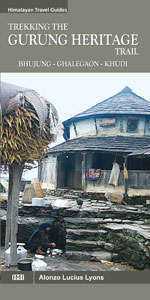 Trekkers wishing to meet few other foreigners will enjoy The Gurung Heritage Trail. Village panoramas with a Himalayan backdrop offer unparalleled beauty, and the cultural interaction is even more rewarding. The Gurung inhabit the higher villages along this route and comprise roughly three percent of the total population of Nepal. They have their own unique language and traditionally engage in agriculture and animal husbandry. Many also serve outside Nepal as Gurkha soldiers. The trek can be done on its own, or combined with the world-renowned Annapurna Circuit. The trails meet up at Khudi, and an additional, rarely used route to Shyange, high above the Marsyangdi River, is provided for those traveling onward.
Trekkers wishing to meet few other foreigners will enjoy The Gurung Heritage Trail. Village panoramas with a Himalayan backdrop offer unparalleled beauty, and the cultural interaction is even more rewarding. The Gurung inhabit the higher villages along this route and comprise roughly three percent of the total population of Nepal. They have their own unique language and traditionally engage in agriculture and animal husbandry. Many also serve outside Nepal as Gurkha soldiers. The trek can be done on its own, or combined with the world-renowned Annapurna Circuit. The trails meet up at Khudi, and an additional, rarely used route to Shyange, high above the Marsyangdi River, is provided for those traveling onward.
QUICK FACTS AND HIGHLIGHTS:
best time to visit: all season trail; views clearest during autumn, and may be too warm from March through August
environment: subtropical to mid-hills
maximum elevation:Ghalegaon(6863 feet, 2092 m)
minimum elevation:Gumle Bazaar (1988 feet, 606 m)
facilities: home stay, lodges, teahouses
duration: 4-5 days
difficulty level: easy to moderate
formalities: Nepal Visa on arrival ($25 USD for 15 days, $40 USD for 30 days, or $100 USD for 3 months); Trekking Information Management System (TIMS) card: currently not needed; Annapurna Conservation Area Project (ACAP) permit: 2000 NRS (not always checked on this route, however, it will be monitored if continuing along the Annapurna Circuit and the fee is doubled if obtained along the trail rather than beforehand in Pokhara or Kathmandu)
food and lodging costs: minimal
typical Nepali dish:daal-bhattarakaari (rice, lentil soup and vegetables)
typical drink:chiyaa (sweet milk tea)
highlights:Gurung people, cultural interaction, village scenery, Nepali hospitality, Himalayan backdrop, rarely visited area
THE INDIGENOUS PEOPLES TRAIL
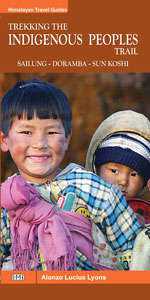 This enchanting mid-hills trek is located entirely in the Mahabharat Range (also known as the Lesser Himalaya) with broad, picturesque vantages of the frosty Greater Himalaya along much of the route. It is a culturally diverse trail that has seen few tourists. Ethnicities prevalent along the way include Sherpa, Tamang, Thami, Majhi, Newar, and Yolmo. Among these groups, the Thami and Majhi are rarely encountered on trekking routes. The Thami are unique to this region. With a total Nepalese population of less than 30,000, their culture is considered endangered. The Majhi, with a Nepalese population under 75,000, traditionally make a living near rivers through fishing and as boat people, mostly in the inner Tarai along the southern belt of Nepal bordering India.
This enchanting mid-hills trek is located entirely in the Mahabharat Range (also known as the Lesser Himalaya) with broad, picturesque vantages of the frosty Greater Himalaya along much of the route. It is a culturally diverse trail that has seen few tourists. Ethnicities prevalent along the way include Sherpa, Tamang, Thami, Majhi, Newar, and Yolmo. Among these groups, the Thami and Majhi are rarely encountered on trekking routes. The Thami are unique to this region. With a total Nepalese population of less than 30,000, their culture is considered endangered. The Majhi, with a Nepalese population under 75,000, traditionally make a living near rivers through fishing and as boat people, mostly in the inner Tarai along the southern belt of Nepal bordering India.
QUICK FACTS AND HIGHLIGHTS:
best time to visit: all season trail; views clearest during autumn, and may be too warm from March through August
environment: subtropical to high-hills
maximum elevation:Sailung Peak (10,325 feet, 3147 m)
minimum elevation:Lubughat(1755 feet, 535 m)
facilities: lodges, home stay, tea houses
duration: 5-7 days
difficulty level: easy
formalities: Nepal Visa on arrival ($25 USD for 15 days, $40 USD for 30 days, or $100 USD for 3 months); Trekking Information Management System (TIMS) card: currently not needed
food and lodging costs: minimal
typical Nepali dish:daal-bhattarakaari (rice, lentil soup and vegetables)
typical drink:chiyaa (sweet milk tea)
highlights: Nepali hospitality, Himalayan panoramas, village scenery, Majhi, Thami and mid-hills ethnic groups, cultural interaction, caves, Tiger Rock, medicinal herbs, religious activity (including Animist, Buddhist, Hindu and Shaman)
